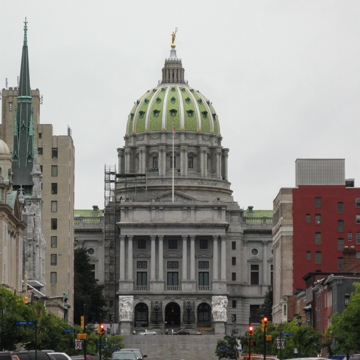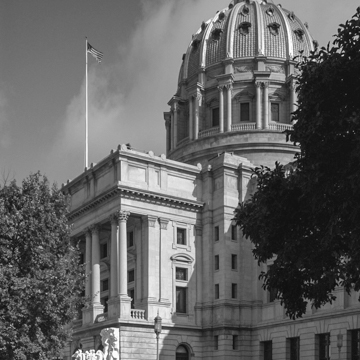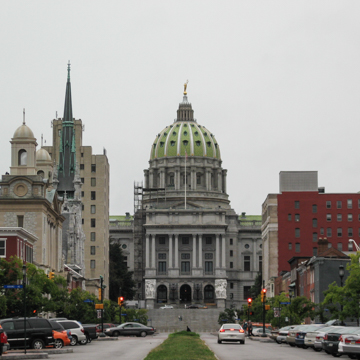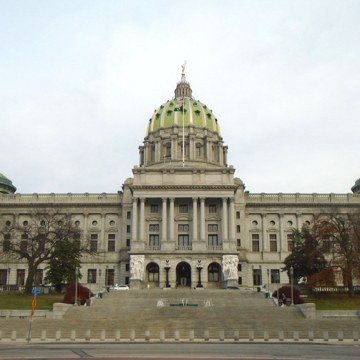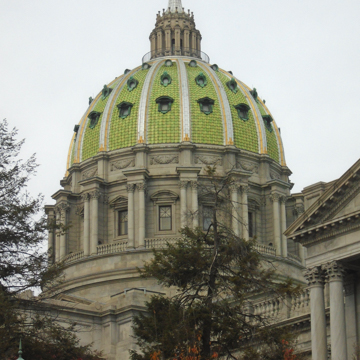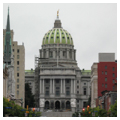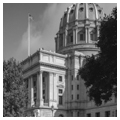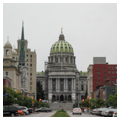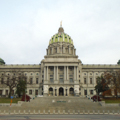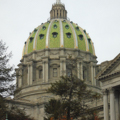The capitol stands on a ridge that rises above the Susquehanna River. The architectural competition to design Pennsylvania's capitol was one of America's first such contests. It was won by Stephen Hills, an English-born architect, who defeated such seasoned professionals as Robert Mills and William Strickland with his miniature version of the U.S. Capitol, complete with its own stately dome. When this burned in 1897, two separate competitions were needed to find a suitable replacement. After the first ended unhappily following scandalous preliminaries in which Frank Furness was publicly condemned for intriguing behind the scenes, the commission was awarded to Chicago architect Henry Ives Cobb. With a shoestring budget of $550,000, Cobb could only build a brick shell with plank partitions—a “hastily erected factory,” as critics called it. In 1901, embarrassed state legislators established a new capitol commission
Joseph Huston took as his theme the representation of Pennsylvania's economic might at the height of the Industrial Revolution with the nation's wealthiest corporations headquartered in its great cities. Cobb's brick walls were reclad in granite, the material most impervious to industrial pollution, while the interior was finished in richly colored marble. Secondary domes are located over stairwells in the new end wings and not over the senate and assembly halls, which remain where Cobb placed them in the wings flanking the rotunda. The interior is remarkable for its lavish decorative program, whose theme is the fulfillment of William Penn's “Holy Experiment.” Pennsylvania artists figured prominently in the decoration, including Henry Chapman Mercer, who provided the decorative floor tiles. Edward Austen Abbey painted the four murals in the dome, The Spirit of Religious Liberty, The Spirit of Light, The Spirit of Vulcan, and Science Revealing the Treasures of the Earth. He also provided the chief mural for the House Chamber, The Apotheosis of Pennsylvania. Violet Oakley contributed the murals for the Senate Chamber, a vibrantly colored cycle that illustrates the formation and preservation of the Union.
Samuel Huston's Handbook of the Pennsylvania Capitol (1907) reported the architect's intent of reviving “the relation between the masterbuilder and his co-workers that one imagines to have existed in the golden days of the Gothic and Renaissance craftsmanship—a comradeship in zeal and proud endeavor.” There was irony here, for much of the recent wealth of Pennsylvania had been created in the previous generation by Frederick Taylor's scientific management that ended the craft culture of the workshop and stimulated such Luddite movements as William Price's Rose Valley shops (see DE26). Nevertheless, when the capitol was largely completed in 1906, President Theodore Roosevelt proclaimed, “It's the handsomest building I ever saw.”
There was even greater irony in Joseph Huston's building, for, if anything, it surpassed the bottomless pit of corruption that made Philadelphia's City Hall (PH49) emblematic of Lincoln Steffens's memorable phrase, “corrupt and contented.” The capitol symbolized the transfer of the culture of plunder to Harrisburg. When a new administration came into power, Huston was charged with corruption for overbilling fantastically for the finishes and the furnishings. At the age of thirty-five he had been at the top of his profession in the state; a few years later, Huston's career was essentially over. He spent several years in another of the state's more ominous architectural monuments, the Eastern State Penitentiary (PH126). Whether he was truly guilty of a corrupt scheme or the victim of a political witch hunt, the grandeur of his conception is clear from the broad flight of stairs that connects it to the streets of the city to the lantern-capped green dome that remains the great landmark of the city's skyline. The building is a remarkable achievement. With the shift to the automobile as the main means
The setting of the capitol is framed by an array of Beaux-Arts buildings that complete a master plan for the capital grounds that extended to the east. It was laid out in 1916 by New Yorker Arnold W. Brunner, who was known for his urban mall plans in Cleveland, Baltimore, Denver, and Rochester. Brunner added the South Office Building immediately to the rear in 1916–1921 and its twin, the North Office Building, in 1920. The later buildings from the 1930s frame the mall and were largely the work of political hacks Gehron and Ross, which the Beaux-Arts classicism of the ensemble partially conceals. In the center is the Soldiers’ Grove. It is now marked by Tides of War, the moving memorial to the state's Congressional Medal of Honor winners designed in 1994 by landscape designer Winifred Lutz with artist Stacy Levy. Bands of stone across the grove bear the names of those who won the medal, including Captain Frank Furness, who was awarded his medal in 1899 for actions thirty-five years earlier.


